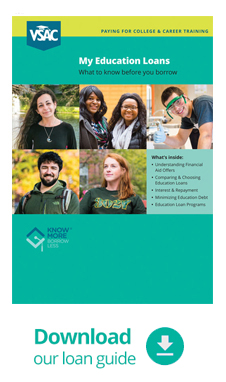Planning for college or training this year? Apply for the Vermont Grant.
Before You Borrow
Most families need help covering the costs of a college degree or training program. Personal savings and free aid like grants and scholarships (money you don’t have to pay back) can go a long way. But you may still need more financing to cover all your costs—including tuition, fees, housing, food, books, transportation, a computer, and other expenses.
Here’s the key: Loans are borrowed money that must be paid back with interest. This means that the amount you repay will always be more than the amount you borrow.
Consider these cost-saving steps before you borrow:
- It's worth repeating: Take advantage of free aid first. Apply for all available grants and scholarships. This “gift aid” doesn’t have to be paid back.
- Use savings and current income. Explore tuition payment plans, which spread payments out over the academic year.
- Accept a work-study job if it's in your financial aid offer. These part-time jobs allow you to earn money toward college expenses. Or consider a part-time job while in school. Studies show that working up to 20 hours a week may actually improve your grades, since you’ll become pretty adept at time management.
- Cut expenses and economize while in school. The cardinal rule? Live like a student in school so you don't have to live like one for 10 years after graduation.
- Understand how the interest rate and the repayment plan you choose will impact your cost of borrowing.
- Borrow only what you need. Your goal should be to minimize loans as much as possible. You can choose to decline a loan or borrow less than what is offered, reducing what you’ll need to pay back.


